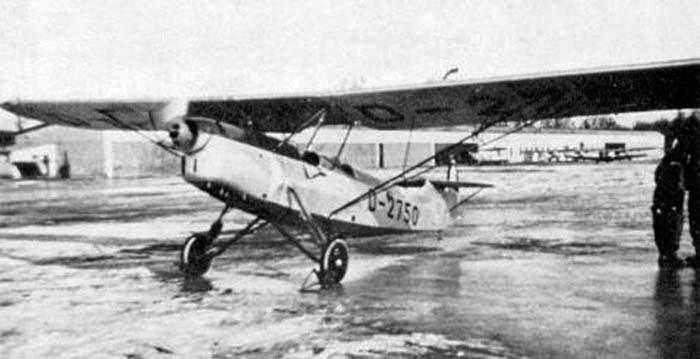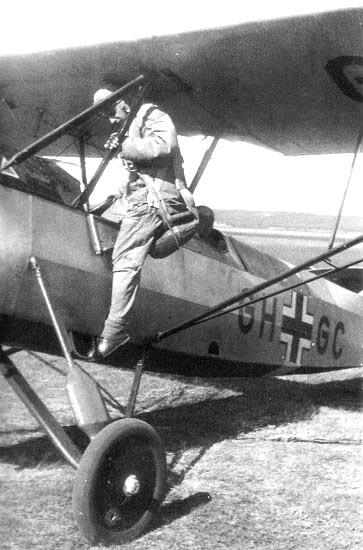In 1930 the company Albatros-Flugzeugwerke GmbH developed in Berlin Johannisthal, secretly commissioned by the Defense Ministry, a two-seat trainer aircraft to train pilots for the commercial pilot schools. As it was forbidden for Germany to develop and build military aircraft the orders came from the Ministry of Transport. The aircraft were then required that it should satisfy both civilian as well as military applications. Such an aircraft was the albatross Al-101, a relatively large strutted high-wing monoplane with fixed tailwheel undercarriage. The fuselage was a steel tube construction with a plywood panel. Only the rear fuselage was covered with fabric.. The wing was a three-piece plywood paneled wooden structure that was left out at the trailing edge so the student pilot course to better visibility for half-round. Wings, the entire wing structure of two strut pairs were additionally supported by the outer wing with large V-struts against the hull. For space-saving reasons, the two outer wings are retracted back. All control surfaces were fabric covered. The tail, also of a wooden structure, was covered with fabric. The landing gear had split axles and had rubber springs . In spring 1932, the aircraft was completed. Quickly apparent massive problems, such as a tendency to flat spins,was discovered, the aircraft was stable around all axes. The wing design proved to be too soft, there was vibration and deformation. After extensive renovations, the designs were changed to Al 101C and D, who received a Argus As 8A / B engine with 135 hp takeoff power. The flight performance were now satisfactory, so that a small series of 30 units were built. A version with a Cirrus "Hermes" engine was reported for Europe Flight 1930 as L101A, but did not start. In 1931, the Focke-Wulf Flugzeugbau GmbH in Bremen took over the Albatroswerke and the Al-101 and Al-102, which was a revised version and equipped with the more powerful Argus As 10C. Al-101, was continued to be built. Only the model designation was changed.
Das Flugzeugmuster L 101 ist in erweitertem Umfange für die gleichen Zwecke, denen bisher in bewährter Weise das Muster Albatros L 82 dient, nämlich Schulung, Sport und Reise, entworfen worden. Bei dieser Fortentwicklung sind in der Gesamtgestaltung des Flugzeuges zwei Maßnahmen von besonderer Bedeutung getroffen worden. Im Gegensatz zu früheren Ausführungen der gleichen Gattung wurde erstmalig die Metallgerippebauweise vollständig, d. h. auch für das Tragwerk übernommen und dabei wesentlich vereinfacht. Eine weitere wesentliche Vereinfachung wurde durch Uebergang zum Eindecker erzielt. Aus Sicherheitsgründen (Ueberschlag) und Sicherheitserfordernissen heraus wurde die Hochdecker-bauart gewählt. Der Anwendungsbereich wurde auf Gruppe K 5 (höchste Kunstflugtauglichkeit) ausgedehnt. Im übrigen geschah die Durchbildung nach den gleichen Grundsätzen wie bei L 82. Ausgerüstet ist das Flugzeugmuster mit einem luftgekühlten 4-Zyl.-Argus-Motor As. 8. Der aus Stahlrohr geschweißte Rumpf hat vor und hinter den beiden Sitzen je einen Gepäckraum. Die Sitze sind für Mitnahme von Rücken kissenfall schirmen eingerichtet. Der hochliegende, abgestiebte Flügel ist aus Dural kästen h olmerA Duralrippen und Durairohrverband aufgebaut.
Die Stoffbespannung ist tropenfähig imprägniert. Die Flügel können zurückgeklappt werden, so daß Abschleppen mit Auto und Unterstellen auf kleinem Raum möglich ist. Sämtliche betriebswichtigen Teile sind gut zugänglich, die Motorhaube ist als Ganzes abklappbar. Das Fahrgestell besitzt Druckgummifederung mit Oeldämpfung (Bauart Albatros) und Albatros-Bremsräder, durch Oeldruck gesteuert. Der Sporn ist einstellbar. Bei einer Zuladung von 350 kg beträgt die Reisegeschwindigkeit 160 km/h, die Reichweite 750 km, die Landegeschwindigkeit 75 km und die Gipfelhöhe 5000
m.
| Type |
Two seat trainer Prototype |
Two seat trainer seaplane W |
Two seat trainer C |
Two seat trainer D |
| Engine |
1 Argus As 8 |
1 Argus As 8 |
1 Argus As 8a |
1 Argus As 8a |
| Dimensions |
Length 8.45 m, span 12.35 m, height 2.70 m, wingarea 20.00 m2, aspect ratio 7.62 |
Length 8.45 m?, span 12.35 m, wingarea 20.00 m2, aspect ratio 7.62 |
Length 8.45 m, span 12.35 m, height 2.70 m, wingarea 20.00 m2, aspect ratio 7.62 |
| Weights |
Empty 445 kg, flying weight 795 kg, wingloading 39.75 kg/m2 |
Empty 600kg, fuel 90 kg, oil 10 kg, load (including pilot) 200 kg, flying weight 800 kg |
Empty 475 kg, fuel 90 kg, oil 10 kg, load (including pilot) 320 kg, flying weight 795 kg, wingloading 39.75 kg/m2 |
| Performance |
Max. speed 160 km/h at sea level, cruising speed at sea level 140 km/h, climb 2.40 m/s, service ceiling 4000 m, range 930 km |
|
Max. speed 170 km/h at sea level, cruising speed at sea level 150 km/h, climb 2.40 m/s, service ceiling 3600 m, range 670 km, endurance 5 h |





